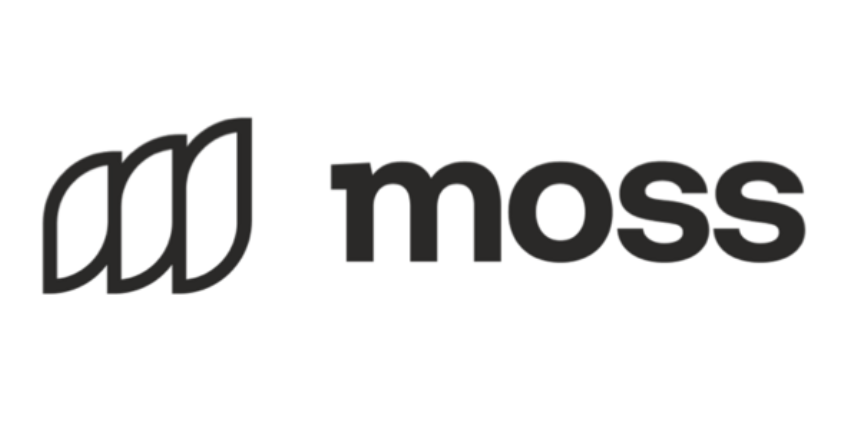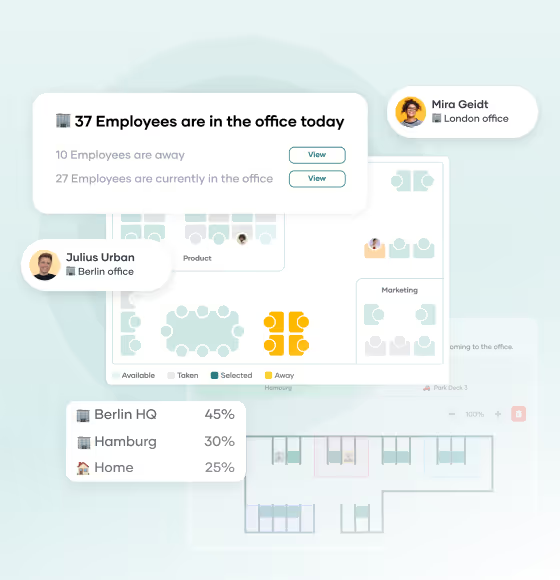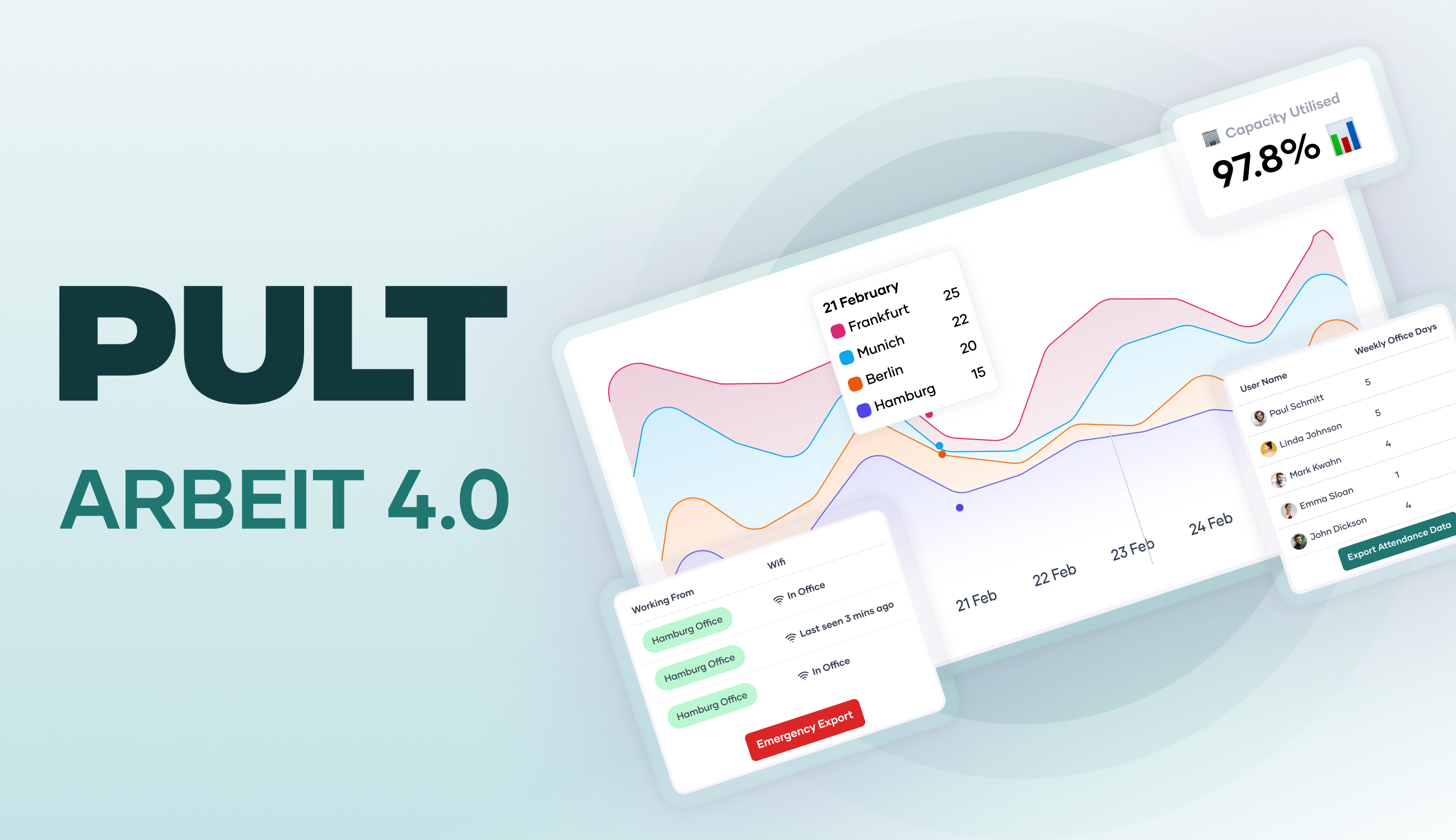How smart workplaces better organize energy, space, and work

Smart workplace: TL;DR
- A smart workplace combines booking systems, sensor technology, and building control to create a holistic office organization.
- The use of workstations and rooms can be measured in a smart workplace, forming the basis for energy, cleaning, and space planning.
- Heating, cooling, and lighting in the smart workplace are controlled according to demand and based on actual usage and occupancy, which reduces energy consumption and operating costs.
- Smart workplaces improve working conditions because employees can find suitable rooms for their respective activities.
What is a smart workplace?
A smart workplace is a workplace concept in which the digital system, building technology, and increasingly artificial intelligence are connected in such a way that people can organize their work better, coordinate more easily, and get things done with fewer resources.
- Digital systems: Communication and information platforms, internal search functions, automated document storage, or AI-supported assistants and agents that take care of routine tasks.
- Building smart workplace technology: Sensors that detect which rooms are in use, software for booking workstations or meeting rooms, and controls for lighting, climate, and energy.
- Connection: The actual “intelligence” arises from the connection between these two areas: When work information and building data are brought together, workstations can be planned proactively, rooms can be used efficiently, and energy can be used sparingly.
Distinction from similar terms:
- Digital workplace primarily refers to the software level, i.e., digital work tools such as intranet, chat, and project management tools.
- Smart office focuses more on the building: sensors, room control, energy consumption.
Why are companies developing smart workplace solutions?
The concept of the smart workplace is gaining importance because companies have to deal with previously unbalanced office space utilization, the massive influx of artificial intelligence, and stricter sustainability requirements.
Technology use and AI adoption
According to Eurostat, 13.5% of companies in the EU use at least one form of AI, with the figure rising to 41.17% for large companies.
Since the end of 2024, Microsoft, Siemens, and other providers have been bringing new approaches such as Microsoft Places and AI-supported workplace analyses to the market, which are designed to significantly simplify the linking of work organization and building control.
Sustainability and regulation
Building control systems in the highest efficiency class can reduce energy consumption in offices by up to 30%.
In summary, companies are under double pressure to act: workplaces must be adapted to changing work habits, while at the same time being operated cost-efficiently and documented sustainably. The intelligent workplace addresses precisely these three requirements.
What systems make up the smart workplace?
A smart workplace includes digital work tools, systems for controlling rooms and workstations, and technologies for measuring and optimizing usage. The interaction of these systems is what defines the smart workplace.
Digital work tools and assistance systems in the smart workplace
- Communication and information platforms such as Microsoft 365 and intranets.
- AI assistants that bundle information, record meetings, or automate routine tasks.
- Uniform access to documents, knowledge databases, and workflows.
Workplace and room organization in the smart workplace
- Systems for booking desks and meeting rooms.
- Dynamic allocation of workstations depending on attendance and team composition.
- Functions such as display of utilization rates or automatic no-show detection.
By switching to shared desks or flexible workstations, companies can save up to 30% of their office space. This space can then be used for other purposes that benefit employees: project areas, modern break areas, or quiet zones for focused work.
Sensors and building technology in the smart workplace
- Occupancy and motion sensors, Wi-Fi data, or digital access controls that show how rooms are actually being used.
- Building automation (heating, lighting, air conditioning) that adjusts consumption to actual occupancy.
Tip: With PULT Presence, you can track your employees' attendance without having to install sensors. As soon as a colleague's laptop or smartphone connects to the company Wi-Fi, their attendance is recorded. This also works with your existing company Wi-Fi.
Analysis and key figures for the use of the smart workspace
- Data platforms that evaluate utilization, energy consumption, and employee satisfaction.
- Key metrics: average space utilization, square meters per workspace, cost per workspace, CO₂ emissions per square meter.
Tip: Office evaluation software should work closely with booking software or combine both in one platform. This gives you reliable figures that you can use to plan your office layout.
Security, data protection, and governance of the smart workplace
- Systems for data anonymization and role-based access.
- Implementation of legal requirements
- Clear governance models for the use, storage, and evaluation of data.
What are the advantages of a smart workplace?
The office space in a smart workplace is used more efficiently, meaning it is better suited to new working models, and operating costs are reduced because sensors and booking data allow for targeted heating, ventilation, and cleaning of rooms and areas.
An important advantage of the smart workplace is the better use of office space. Many traditional workplaces are regularly empty because teams work hybrid and are not in the office every day. Instead of keeping such spaces unused, you can remove them and useyour smart hybrid workplace for more meaningful purposes:
- Project areas with rollable furniture, media technology, and room dividers.
- Zones for collaboration within teams or with customers.
- Quiet rooms for breaks or quiet, focused work.
- Modern break areas with upholstered furniture, equipped kitchens, canteen, beverage, and snack offerings, or play areas for relaxation.
With offerings of this kind, you give your employees access to resources that they actually want and that enable them to have a significantly higher-quality workspace experience.
Reducing operating costs in the smart workplace
A smart workplace reduces operating costs primarily because sensors and booking software show when rooms are occupied and how long they are used.
This data makes it possible to control heating, cooling, and ventilation in a targeted manner instead of supplying entire office spaces permanently. Cleaning services can also be scheduled according to demand: a conference room that has not been used does not need to be cleaned every day.
In this way, resources are used more sparingly and running costs are significantly reduced without compromising employee comfort.
Data protection in the smart workplace
The introduction of a smart workplace affects legal requirements that companies must comply with.
- Purpose limitation and data minimization: Data on the use of workstations or rooms may only be processed for the purpose of workplace organization or building control. Personal data must be limited to the minimum necessary, anonymized or aggregated as far as possible.
- Consent and legal basis: When personal data is collected, either a legal basis or the consent of the employees is required. This consent must be given voluntarily and must not be linked to any disadvantages.
Tip: With PULT, you work in full compliance with the GDPR. Workplace booking and office evaluation do not allow any conclusions to be drawn about the behavior of individual employees. Instead, the data is aggregated statistically and shows you how your office, rooms, and zones are actually being used.
Workplace booking at the smart workplace
The smart workplace thrives on the targeted and conscious use of workplaces and rooms. For this to succeed, employees need to know which spaces are available to them and when. Workplace booking forms the binding basis for this.
Such a booking system shows which seats, meeting rooms, or project zones are available. Employees can plan their working day and see when colleagues are in the office and where they will be sitting.
PULT, as a smart workplace software, gives you a realistic picture of actual usage: When is the office at full capacity, which areas remain empty at times, which rooms and zones are in high demand? This data forms the basis for managing space, cleaning, and energy according to demand.
- PULT workplace and room booking: Make binding reservations for desks, meeting rooms, project zones, and parking spaces directly via desktop or app.
- PULT Presence: Automatic attendance tracking via the company Wi-Fi to compare actual usage and booking data.
- Weekly planner: Overview of who is in the office and when, and easy coordination of joint team days.
- Office Insights: Evaluate utilization and attendance in real time to control cleaning cycles, energy consumption, and room allocation.
{{onpage-cta}}
What is a smart workplace?
A smart workplace combines digital work tools such as booking systems or AI assistance with building technology such as sensors and automation. The aim is to make workplaces more responsive to needs, save energy overall, and make day-to-day work easier.
What are the advantages of a smart workplace for companies?
It reduces operating costs by controlling heating, cooling, and cleaning according to demand. At the same time, it improves the use of office space and creates better working conditions for employees.0
How does the smart workplace differ from the digital workplace?
A smart digital workplace primarily describes software solutions such as intranet, chat, or project platforms. The smart workplace goes further because it also incorporates the physical working environment, i.e., rooms, energy consumption, and workplace utilization.
What technologies are part of the smart workplace?
Typical elements include workplace and room booking systems, presence and occupancy sensors, building automation for heating, air conditioning, and lighting, as well as analysis platforms that visualize usage and costs.
A new hybrid workplace experience is coming. Start Now. 🎉
Distribute and book workstations, rooms, and zones fairly. With PULT.





















.avif)




